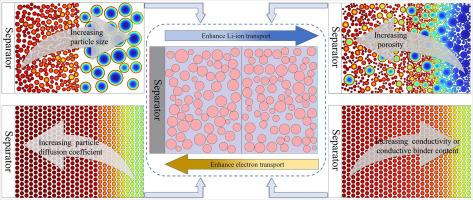Synergistic enhancement of Li-ion and electron transport in thick electrodes via tailored microstructural gradients
IF 5.6
3区 材料科学
Q1 ELECTROCHEMISTRY
引用次数: 0
Abstract
The global transition to decarbonization and the rapid rise of electric mobility demand lithium-ion (Li-ion) batteries with higher energy density. Thick electrodes offer a viable pathway but introduce microstructural complexity that impedes Li-ion and electron transport. In this study, a heterogeneous particle-packing model with active material-binder gradients is developed to investigate how gradients in particle size, particle diffusion coefficient, porosity, electronic conductivity, and conductive binder content enhance electrode performance from the perspectives of Li-ion and electron transport. The results reveal that: (1) particle-size gradients combine lower tortuosity from large particles with shorter diffusion paths from small particles; (2) diffusion-coefficient gradients facilitate Li-ion insertion near the separator; (3) porosity gradients enhance Li-ion transport in the electrolyte while maintaining energy density; and (4) conductivity and binder gradients improve electronic pathways. At higher discharge rates and greater electrode thickness, Li⁺ accumulation intensifies near the separator, while overpotential rises markedly adjacent to the current collector. Consequently, an effective strategy for thick electrode design is to enhance ionic transport at the separator side in combination with enhanced electronic conductivity at the current collector side. These insights provide guiding principles for the rational design of high-performance thick electrode architectures.

通过定制微结构梯度协同增强锂离子和电子在厚电极中的传输
全球向脱碳转型和电动汽车的快速崛起对具有更高能量密度的锂离子(Li-ion)电池提出了需求。这……
本文章由计算机程序翻译,如有差异,请以英文原文为准。
求助全文
约1分钟内获得全文
求助全文
来源期刊

Electrochimica Acta
工程技术-电化学
CiteScore
11.30
自引率
6.10%
发文量
1634
审稿时长
41 days
期刊介绍:
Electrochimica Acta is an international journal. It is intended for the publication of both original work and reviews in the field of electrochemistry. Electrochemistry should be interpreted to mean any of the research fields covered by the Divisions of the International Society of Electrochemistry listed below, as well as emerging scientific domains covered by ISE New Topics Committee.
 求助内容:
求助内容: 应助结果提醒方式:
应助结果提醒方式:


